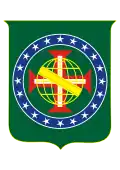Joaquim Nabuco
Joaquim Aurélio Barreto Nabuco de Araújo (August 19, 1849 – January 17, 1910) was a Brazilian writer, statesman, and a leading voice in the abolitionist movement of his country.
Joaquim Nabuco | |
|---|---|
 Nabuco in 1902 | |
| Ambassador of Brazil to the United States | |
| In office May 23, 1905 – January 17, 1910 | |
| Nominated by | Rodrigues Alves |
| Preceded by | Alfredo de Morais Gomes Ferreira |
| Succeeded by | Domício da Gama |
| Ambassador of Brazil to the United Kingdom | |
| In office February 4, 1901 – January 10, 1905 | |
| Nominated by | Campos Sales |
| Preceded by | João Artur de Sousa Correia |
| Succeeded by | Francisco Régis de Oliveira |
| Member of the Chamber of Deputies | |
| In office July 3, 1885 – November 15, 1889 | |
| Constituency | Pernambuco |
| In office January 13, 1879 – January 17, 1882 | |
| Constituency | Pernambuco |
| Personal details | |
| Born | Joaquim Aurélio Barreto Nabuco de Araújo August 19, 1849 Recife, Pernambuco, Brazil |
| Died | January 17, 1910 (aged 60) Washington, D.C., U.S. |
| Spouse |
Evelina Torres Soares Ribeiro
(m. 1889) |
| Children | Maurício Joaquim Carolina Mariana José Tomás |
| Alma mater | Faculty of Law of Recife |
| Occupation | Diplomat and politician |
| Signature | |
| Part of a series on |
| Conservatism in Brazil |
|---|
 |
Early life and education
Born in Brazil, Joaquim was the son of a major political figure in the Brazilian Empire, José Tomás Nabuco (1813–1878), a lifetime senator, counselor of state, and wealthy landowner. José made his move from conservativism to liberalism in the 1860s, establishing the Liberal Party in 1868, and supporting the reforms that would lead to the abolition of slavery in 1888.[1]
Personal life
Joaquim Nabuco spent most of his time from 1873 to 1878 traveling and living abroad. In his youth, Nabuco had a 14-year relationship with financier and philanthropist Eufrásia Teixeira Leite, who held one of the largest fortunes in the world at the time. The romance with Nabuco began during a trip by ship to Europe, in 1873, and would last until 1887, when Eufrásia sent her last letter to Joaquim Nabuco. Two years later, at 38 years old, he married Evelina Torres Soares Ribeiro. Nabuco was a friend of the famous writer Machado de Assis.
Career

After returning to Brazil in 1878, Nabuco began his public fight against slavery through his political activity and in his writings. He campaigned against slavery in the Chamber of Deputies from 1878, and he founded the Brazilian Anti-Slavery Society. In 1883, he wrote probably the most important work against slavery in the Portuguese language: O Abolicionismo. Although he was largely responsible for the abolition of slavery in 1888, contemporary affirmative action intellectuals believe his reasons for doing so were related to an elitist fear of slavery "Africanizing" Brazil. He is quoted as saying, "Free labor and slave labor cannot coexist, and neither can slavery and immigration".[2] However, it is hard to explain, under this view, why Nabuco would want Africans to become free citizens when slave traffic had already been prohibited.
After the overthrow of the Brazilian monarchy he retired from public life for a period of time.
He later became the first ambassador from Brazil to the United States from 1905–1910, which marked a significant shift in his country's role in the world arena. Nabuco realized the importance for Brazil, and other South American nations, to develop a united relationship with the North American stage. In Washington, he worked with Elihu Root who also supported this idea of Pan-Americanism.[3] He spent many years in both England and France, where he was a strong proponent of Pan-Americanism, presiding over the 1906 Pan-Americanism conference.[4] Following Nabuco's death on January 17, 1910, the Pan-American Building in Washington, D.C. was finally completed. At the dedication ceremony the Secretary of State said the following words about him: “One voice that should have spoken here today is silent, but many of us cannot forget or cease to mourn and to honor our dear and noble friend, Joaquim Nabuco. Ambassador from Brazil, dean of the American diplomatic corps, respected, admired, trusted, loved and followed by all of us, he was a commanding figure in the international movement of which the creation of this building is part…”[5]
His best known work is his autobiography Minha formação, published in 1900. It vividly portrays the slave-holding society in 19th century Brazil.
Of his major works, Minha formação and O abolicionismo have been translated into English, as My Formative Years[6] and Abolitionism[7] respectively.
References
- "Joaquim Nabuco, Conservative Historian", Richard Graham, Luso-Brazilian Review, Vol. 17, No. 1 (Summer, 1980), pp. 1–16
- Sales Augusto dos Santos, translated by Laurence Hallewell, "Historical Roots of the 'Whitening' of Brazil" in the journal Latin American Perspectives, 2002.
- Henrich, Nathalia (January 30, 2019). "Joaquim Nabuco e Oliveira Lima em diálogo: separados pelos Estados Unidos". Revista de Historia de América (156): 181–215. doi:10.35424/rha.156.2019.238. ISSN 2663-371X.
- Henrich, Nathalia (October 5, 2017). "La III Conferencia Panamericana en Río de Janeiro (1906) y las relaciones entre Brasil y Estados Unidos". Revista de Estudios Brasileños (in Spanish). 4 (8). doi:10.3232/REB.2017.V4.N8.3069. ISSN 2386-4540.
- Ronald Hilton and Alexander Wyse, Reviewed Work: '"The Life of Joaquim Nabuco" by Carolina Nabuco' in the journal of The Americas, 1950.
- "Signal Books | My Formative Years".
- Nabuco, Joaquim (1977). Abolitionism: The Brazilian Antislavery Struggle. ISBN 9780252006012. OCLC 884384441.
External links
 Media related to Joaquim Nabuco at Wikimedia Commons
Media related to Joaquim Nabuco at Wikimedia Commons- Works by Joaquim Nabuco at LibriVox (public domain audiobooks)

.svg.png.webp)

